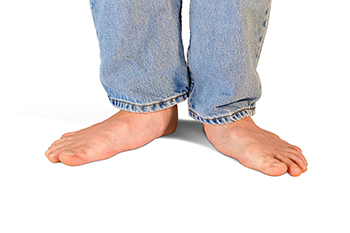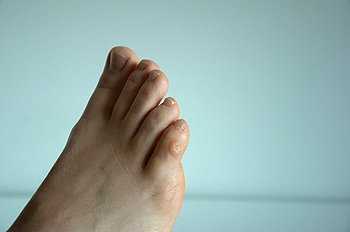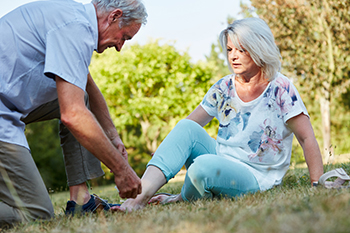Blog
Items filtered by date: December 2022
Effects of Overpronation

Pronation is simply how your foot hits the ground when you walk or run. When someone overpronates, it means that the foot rolls inward when taking a step. The outer edge of the heel generally hits the ground first, and then the foot rolls in toward the arch. This motion may put extra pressure on the muscles, tendons and ligaments. Overpronation can lead to a number of injuries, including ankle sprains, Achilles tendonitis, and plantar fasciitis. One way to determine whether or not you overpronate is to check out the bottom of your shoes. If the shoe is worn on the inside of the sole nearest the big toe, it may indicate overpronation. Next, stand in bare feet and look into a mirror to see if your feet are flat or have low arches. This is another indicator of overpronation. Symptoms of overpronation include heel or arch pain, flat feet, hammertoes, or pain in the knees, hips, or back. To be certain, it is a good idea to visit a podiatrist who can conduct a more formal examination and determine if orthotics can help to correct the condition.
If you have any concerns about your feet, contact one of our doctors from Kitsap Foot & Ankle Clinic. Our doctors can provide the care you need to keep you pain-free and on your feet.
Biomechanics in Podiatry
Podiatric biomechanics is a particular sector of specialty podiatry with licensed practitioners who are trained to diagnose and treat conditions affecting the foot, ankle and lower leg. Biomechanics deals with the forces that act against the body, causing an interference with the biological structures. It focuses on the movement of the ankle, the foot and the forces that interact with them.
A History of Biomechanics
- Biomechanics dates back to the BC era in Egypt where evidence of professional foot care has been recorded.
- In 1974, biomechanics gained a higher profile from the studies of Merton Root, who claimed that by changing or controlling the forces between the ankle and the foot, corrections or conditions could be implemented to gain strength and coordination in the area.
Modern technological improvements are based on past theories and therapeutic processes that provide a better understanding of podiatric concepts for biomechanics. Computers can provide accurate information about the forces and patterns of the feet and lower legs.
Understanding biomechanics of the feet can help improve and eliminate pain, stopping further stress to the foot.
If you have any questions please feel free to contact one of our offices located in Bremerton and Port Orchard, WA . We offer the newest diagnostic and treatment technologies for all your foot and ankle needs.
Three Types of Corns

A small, hardened area of skin that has formed on the foot may indicate a corn has developed. They generally develop on the outside of the pinky toe, or on the bottom of the foot, as a result of excessive friction. This can happen from wearing shoes and socks that are too tight, and temporary relief may come from choosing to wear shoes that fit correctly. A corn on the foot can cause severe pain and discomfort, despite their small size. There are three types of corns that can develop, consisting of hard, soft, and seed corns. The former is considered to be the most common type of corn, and can develop on top or on the side of the toes. Soft corns generally develop between the toes, as a result of excess moisture that can accumulate there. The latter forms on the soles of the feet, and are generally small in size. Research has shown the best method to prevent a corn from developing is by wearing shoes that are comfortable. This is generally successful in alleviating pressure against the toes. Many people who have developed corns seek the advice of a podiatrist who can effectively remove them, and offer additional prevention techniques.
Corns can make walking very painful and should be treated immediately. If you have questions regarding your feet and ankles, contact one of our doctors of Kitsap Foot & Ankle Clinic. Our doctors will treat your foot and ankle needs.
Corns: What Are They? And How Do You Get Rid of Them?
Corns are thickened areas on the skin that can become painful. They are caused by excessive pressure and friction on the skin. Corns press into the deeper layers of the skin and are usually round in shape.
Ways to Prevent Corns
There are many ways to get rid of painful corns such as:
- Wearing properly fitting shoes that have been measured by a professional
- Wearing shoes that are not sharply pointed or have high heels
- Wearing only shoes that offer support
Treating Corns
Although most corns slowly disappear when the friction or pressure stops, this isn’t always the case. Consult with your podiatrist to determine the best treatment option for your case of corns.
If you have any questions please feel free to contact one of our offices located in Bremerton and Port Orchard, WA . We offer the newest diagnostic and treatment technologies for all your foot and ankle needs.
Plantar Warts Can Be Treated!
Buddy Taping Method for Mildly Fractured Toes

A broken toe can wreak havoc while attempting to complete daily activities, and it may happen for various reasons. These can include stubbing it into a piece of furniture, which is generally the pinky toe, or from dropping a heavy object on it. Most people experience immediate pain, bruising, and swelling with a broken toe, and promptly seek medical attention. If the fracture is mild, the buddy taping method may work well. This is done by taping the broken toe to the toe next to it, which is generally successful in providing the stability that is needed as the healing process occurs. It is beneficial to stay off of the foot as much as possible, and frequently elevating it may reduce some of the swelling. If the break is severe, a bone may protrude from the toe, piercing the skin, and it may look deformed. This type of fracture needs immediate medical attention from a podiatrist, and it is suggested that you contact this type of doctor who can diagnose and treat your broken toe accordingly.
Broken toes may cause a lot of pain and should be treated as soon as possible. If you have any concerns about your feet, contact one of our doctors from Kitsap Foot & Ankle Clinic. Our doctors will treat your foot and ankle needs.
What Is a Broken Toe?
A broken toe occurs when one or more of the toe bones of the foot are broken after an injury. Injuries such as stubbing your toe or dropping a heavy object on it may cause a toe fracture.
Symptoms of a Broken Toe
- Swelling
- Pain (with/without wearing shoes)
- Stiffness
- Nail Injury
Although the injured toe should be monitored daily, it is especially important to have a podiatrist look at your toe if you have severe symptoms. Some of these symptoms include worsening or new pain that is not relieved with medication, sores, redness, or open wounds near the toe.
If you have any questions, please feel free to contact one of our offices located in Bremerton and Port Orchard, WA . We offer the newest diagnostic and treatment technologies for all your foot care needs.
Elderly People May Be Prone to Foot Conditions

Many people are aware of how the feet are affected as the aging process occurs. Research has shown there is a direct connection with foot health and walking. The feet can maintain strength when walking everyday, which may help improve balance and weight bearing. Other benefits can include increased socialization and independence. Some of the common signs that people notice with age consist of hair loss below the knee, age spots, and the number of corns and calluses that may increase. Additionally, a loss of muscle mass may happen because of inactivity, and this could lead to a foot injury. Some of the foot ailments that are common in the elder population can include plantar fasciitis and onychomycosis, which is the medical term for toenail fungus. Ingrown toenails can also fall into this category and these conditions often need medical attention for complete healing. It is beneficial for elderly patients to be under the care of a podiatrist who can offer effective treatment options, in addition to performing regular foot examinations.
Proper foot care is something many older adults forget to consider. If you have any concerns about your feet and ankles, contact one of our doctors from Kitsap Foot & Ankle Clinic. Our doctors can provide the care you need to keep you pain-free and on your feet.
The Elderly and Their Feet
As we age we start to notice many changes in our body, but the elder population may not notice them right away. Medical conditions may prevent the elderly to take notice of their foot health right away. Poor vision is a lead contributor to not taking action for the elderly.
Common Conditions
- Neuropathy – can reduce feeling in the feet and can hide many life-threatening medical conditions.
- Reduced flexibility – prevents the ability of proper toenail trimming, and foot cleaning. If left untreated, it may lead to further medical issues.
- Foot sores – amongst the older population can be serious before they are discovered. Some of the problematic conditions they may face are:
- Gouging toenails affecting nearby toe
- Shoes that don’t fit properly
- Pressure sores
- Loss of circulation in legs & feet
- Edema & swelling of feet and ankles
Susceptible Infections
Diabetes and poor circulation can cause general loss of sensitivity over the years, turning a simple cut into a serious issue.
If you have any questions please feel free to contact one of our offices located in Bremerton and Port Orchard, WA . We offer the newest diagnostic and treatment technologies for all your foot and ankle needs.

